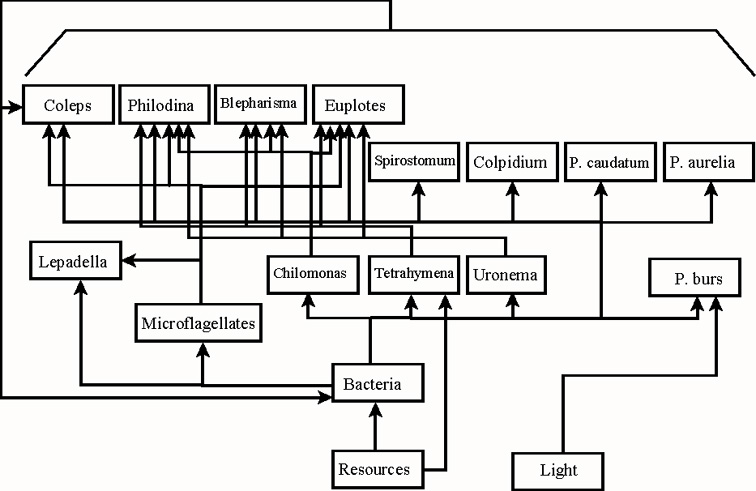
Appendix A. A table and a figure describing the biological community of our study.
Table A1. Species used, their taxonomic affiliations, maximum size, relative size class, and dietary needs: B = bacterivore, O = omnivory on small flagellates and/or ciliates, S = scavenger of decaying organisms, P = photosynthetic, and R = direct resource utilization. (Data from personal observations, Peterson [1992] for protozoans, and Smith [2001] for rotifers.)
Species |
Type |
Maximum size (μm) |
Size class |
Diet |
Blepharisma americanum |
Ciliate |
300 |
L |
B/O |
Chilomonas sp. |
Flagellate |
40 |
S |
B |
Coleps sp. |
Ciliate |
50 |
S |
B/S |
Colpidium striatum |
Ciliate |
100 |
M |
B |
Euplotes sp. |
Ciliate |
150 |
M |
B/O |
Lepadella sp. |
Rotifer |
150 |
M |
B/O |
Microflagellates |
Flagellate |
<10 |
S |
B |
Paramecium Aurelia |
Ciliate |
150 |
M |
B |
Paramecium bursaria |
Ciliate |
200 |
M |
B/P |
Paramecium caudatum |
Ciliate |
250 |
L |
B |
Philodina sp. |
Rotifer |
400 |
L |
B/O |
Spirostomum sp. |
Ciliate |
1000 |
L |
B |
Tetrahymena thermophila |
Ciliate |
50 |
S |
B/R |
Uronema sp. |
Flagellate |
25 |
S |
B |
 |
| FIG. A1. The potential complete food web for the organisms used in this experiment. |
LITERATURE CITED
Peterson, D. J. 1992. Free-living freshwater protozoa. CRC Press, Boca Raton, Florida, USA.
Smith, D.G. 2001. Pennak’s Freshwater Invertebrates of the United States: Porifera to Crustacea. John Wiley and Sons, New York, New York, USA.